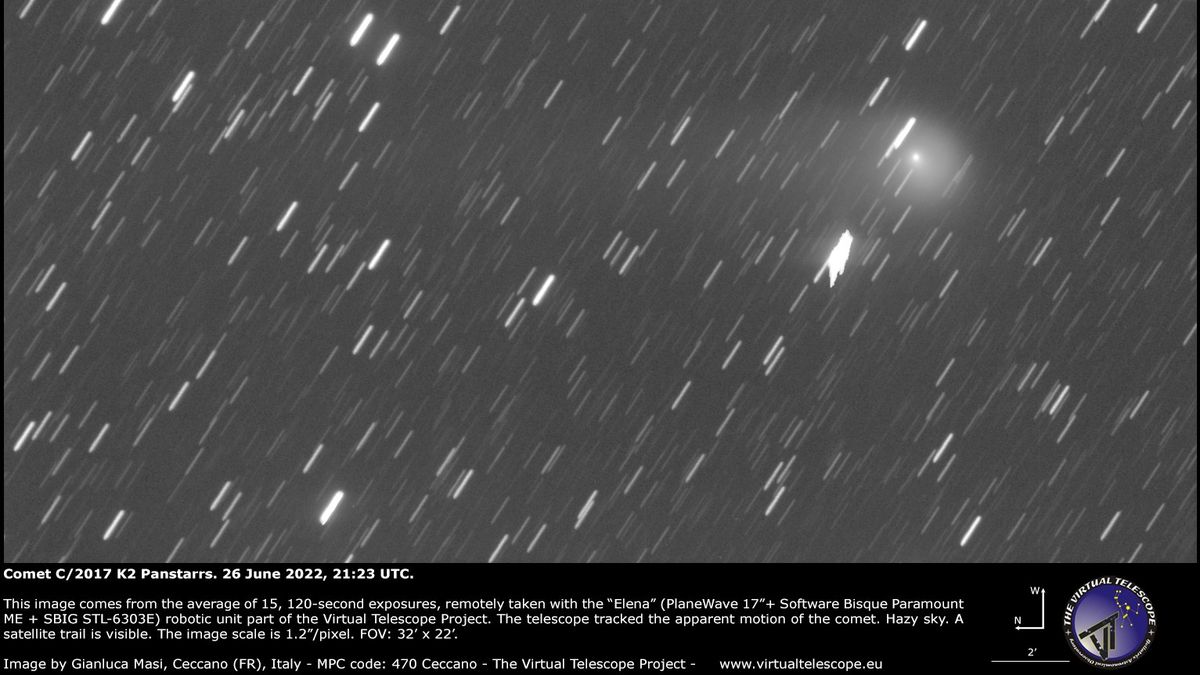
A megacomet has just passed safely by Earth, but there's still a chance it will grow brighter through the summer as it reaches its closest approach to the sun in December.
Comet C/2017 K2 (PANSTARRS), called K2 for short, made its closest approach to our planet on Thursday (July 14). It passed 168 million miles (270 million kilometers) from Earth (beyond the orbit of Mars).
This distant approach meant that K2 had a bit of a dim showing, despite its sheer size. The megacomet was first spotted in 2017 by the Panoramic Survey Telescope and Rapid Response System (PanSTARRS) in the outer reaches of the solar system.
But there's more to come, as K2 now continues its journey to the sun and will make its closest approach to the star around which it orbits, the so-called perihelion, in December. The comet, which is visible these days by large amateur telescopes, may brighten up in the warmer environment closer to the sun and move into average binocular range if we are lucky.
Related: The massive, strange Comet K2 is touring the solar system, surprising scientists as it goes
The first observations of the comet revealed a potentially large nucleus (or core) and a huge envelope of gas and dust. At that time, the comet was between the orbits of Saturn and Uranus, about 1.49 billion miles (2.4 billion km) from the sun, which is about 16 times farther away than Earth is from the sun. The fact that K2 already sported the gaseous coma surprised scientists, as this deep in the solar system, temperatures are so cold that comets, mostly made of water ice, are supposed to be as still and dead as rocks.
Scientists still debate how big the comet is. The Canada–France–Hawaii Telescope (CFHT) suggested K2's nucleus could be between 18 and 100 miles (30 to 160 km) wide, but data from the Hubble Space Telescope showed it might be only 11 miles (18 km) wide.
Related stories:
Comet activity is always tough to predict, as we cannot say exactly how the sun's heat will affect K2 or whether it will survive the passage at all. Now poised at about magnitude 7 or 8, the comet should remain viewable in telescopes through at least the rest of the summer. Naked-eye visibility is magnitude 6, by comparison.
Perihelion will happen on Dec. 19 and so far, the comet has been getting brighter as it moves toward the inner solar system. So we can only hope that in the coming weeks, the comet will get a little brighter so that more people will be able to see it beyond the pictures coming in from larger observatories.
Perihelion will also be distant, as K2 will be about 1.8 astronomical units from the sun (nearly double the distance between Earth and the sun), when it makes the closest approach.
Follow Elizabeth Howell on Twitter @howellspace (opens in new tab). Follow us on Twitter @Spacedotcom (opens in new tab) and on Facebook (opens in new tab).
"Stop" - Google News
July 15, 2022 at 05:05PM
https://ift.tt/psaVnk9
Goodbye, Comet K2! Next stop: closest approach to the sun - Space.com
"Stop" - Google News
https://ift.tt/B4oi7gH
https://ift.tt/1DNsw8F
Bagikan Berita Ini















0 Response to "Goodbye, Comet K2! Next stop: closest approach to the sun - Space.com"
Post a Comment